A fleet of new electric buses are being rolled out along bus route 63, and they include a number of new innovations that are being tested together for the first time.
The new buses have been under development for a couple of years, and they are slightly experimental, in that a lot of ideas are being tried at the same time. If they work, great, but it’s considerably cheaper to remove something that people don’t like than to add it later if tests elsewhere show it worked.
So, a new fleet of buses started rolling out on route 63 a few weeks ago, with a range of new ideas.
Some of them are very obvious when you look around, such as the removal of the grab poles on the upper deck, replaced with every single seat having a grab handle. Every seat, even the window seats. That gives the upper deck a much cleaner appearance, but it also means there are more grab handles to hold on to compared to the few poles that used to be there.
Each of the seats comes with a phone charger socket and a flip-down phone holder, as well as the stop button for the bus driver.
Probably most dramatic though is the sunlight in the front of the upper deck, which is tinted to prevent it being a heat trap. However, the bus also has air conditioning as well, and that runs the full length of the bus in vents above the seats. And yes, the windows can still be opened if necessary.
Upgraded iBus displays have been fitted that show duration to the next stops and any local transport issues.
Another change is the floor, it’s a wooden effect lino. It’s subjective, but it does look nicer than the classic patterned lino flooring and yes, it does add a bit of style to the otherwise overly generic bus appearance.
Externally, in addition to the destination board on the front and by the front door showing both the route number and destination, they’ve also upgraded the back of the bus. Here, traditionally, only the bus route number is shown, but they’ve put the destination on as well. A small, but helpful addition.
The aim is for the buses to be seen as a bit more than simply a necessity for getting people from A to B, but as a form of transport that’s responding to changing passenger expectations. Air conditioning, phone charging, and environmentally friendly. By being more appealing to people in the post-pandemic work, TfL hopes to embed a generational shift in transport expectations away from motor cars to electric buses. If more people switch to buses, then that’s fewer cars on the road, which in turn lets buses go faster and be more reliable, which in turn makes them more desirable to use instead of cars. A virtuous circle is created.
TfL will use customer feedback from route 63 to inform plans for the wider bus network and which features may need tweaking in future bus orders.
The buses themselves were built in Scarborough by Alexander Dennis (ADL), based on a chassis supplied by China’s BYD, and then ADL handles the coach building above the chassis. There are plans to import the BYD chassis in parts to assemble them in the UK, so creating more UK jobs, but that’s dependent on bus companies being able to make reliable commitments to orders.
TfL is still waiting to find out what its long term funding situation will be, but for bus manufacturers, as important as TfL is as a customer, ideally, all UK transport operators would have reliable funding so that suppliers can plan and invest as well. That investment is needed as these new buses are replacing older buses that are at the end of their practical life, and it becomes progressively more expensive to keep them on the road. You reach a point where it’s cheaper to buy new buses, but that needs everyone to have clarity about their long-term finances.
However, for electric buses to be plying the city streets, it’s not just the buses that need replacing, the bus depots also need upgrading.
The obvious change in the garage is that petrol pumps need to be replaced with electrical chargers. This isn’t a simple swap job though, for while buses can drive up to a petrol pump and be refuelled very quickly, charging batteries takes time. To do that, the bus garage is being fitted with rows of 150KW chargers, although it’s worth noting that the buses are currently charged at 112KW, so there’s the capacity to upgrade at a later date.
Most of the chargers are along the walls, but they’ve also needed to put some in the middle of the parking space for the buses, and that’s an issue as buses tend to be packed tightly together, and the chargers took over space for a whole row of buses, so they have to redesign the parking layout to handle this.
The buses can be charged in around 3 hours, but you can’t have a fleet of buses all plugged in at the same time as there’s not enough electricity to support that.
Getting extra electrons is often the hardest part of upgrading a bus fleet, as higher power cables and substations need to be installed and that is a very complicated process. Here at Walworth Depot, they have two supplies. One is live now, and it also charges a gigantic local storage battery that can be used to supply surge charging on demand. A second supply is due to go live very shortly.
The buses can run for around 150-170 miles on a single charge, which is generally enough for a full day of service. As the depot is part way along the route, it’s also easy to divert the buses to the garage for a top-up if needed though.
Something that extends the life of the battery charge is heating. A typical bus heats up in the morning as it drives around town, but the electric buses will be warmed up before they leave the depot. While that’s done so that the heaters draw less electricity from the battery during the day, it also means passengers get warm busses first thing in the morning. A decision of necessity has improved passenger comfort.
Each depot faces different challenges in converting to electricity, and this one was chosen as route 63 takes in a wide swathe of London, from the offices and centre of London, down through the residential and commuter areas of Camberwell and Honor Oak, where transport links are weaker than in other parts of London.
The route upgrade comes as ridership between on route 63, between King’s Cross and Honor Oak, has returned to close to pre-pandemic levels.
For route 63, some electric buses are already in use, and the remaining diesel powered buses on the route will be phased out over the next couple of months. That’ll mean that road pollution along route 63 will reduce as the buses are zero-emission at source, but also the air pollution inside the bus garage will be almost eliminated, for the benefit of the staff.
But importantly for bus photographers, the digital destination boards on the front of the buses have a faster screen refresh rate than older digital displays, so no more problems of taking a photo, only for half the destination board to be missing due to the screen refresh.
Keeping passengers and bus geeks happy.

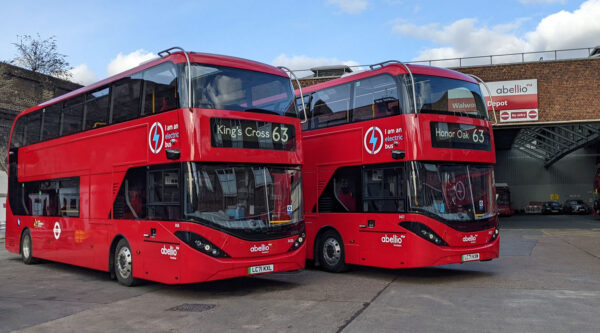
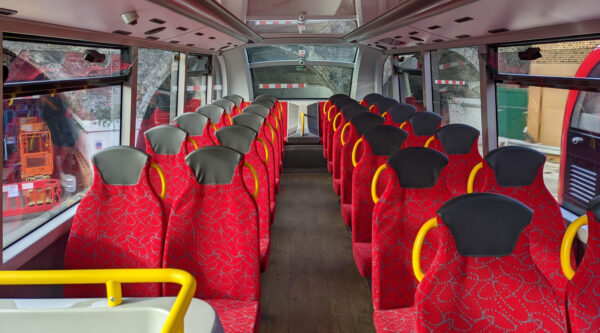
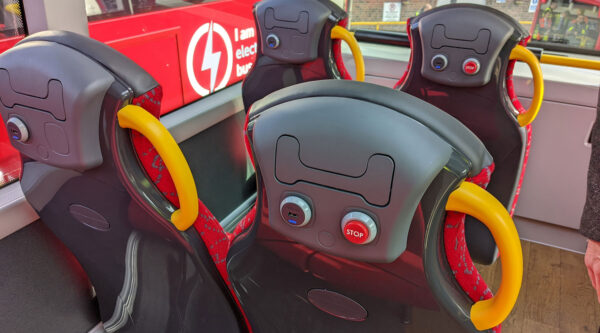
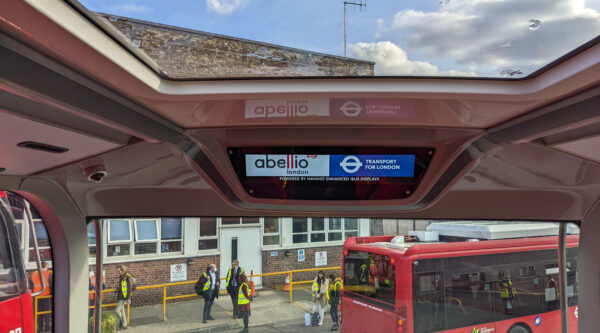
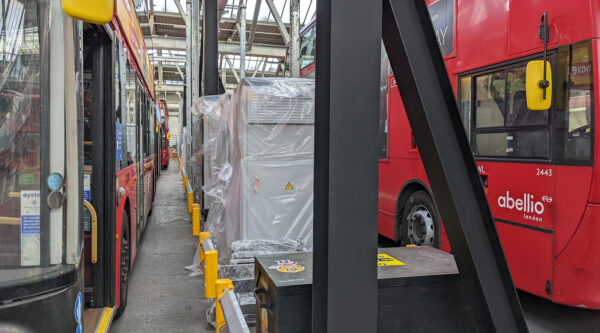






Interesting post thanks
Does anyone know the purpose of the metal handles at the front & top of these buses?
Tree deflectors
They are fenders to prevent the bodywork being damaged by tree branches or other projections.
Yay, buses that passengers can see out of .. again.
Those phone holders will last about 3 minutes
As some of the buses have been in use for a few weeks now, and have not suffered the damage you said would occur within 3 minutes, would you care to adjust your timeline?
Blackpool Transport have had the same phone holders for many years without problems. It is the USB power sockets which are the fragile part. The newer buses have wireless charging integrated into the phone holder and that works much better. Do the TfL buses have this?
Truly the end of the roller-blinds then?
Would be interesting to a run through some of the city with the rooflight to see the buildings from a new perspective…
(FYI the article says “sunlight”, but means “rooflight” or “sunroof”)
New buses with chargers on 160 route too.
Not keen on the seat grab handles. It looks as tho’ a large passenger will cover it with their shoulder. “Excuse me sir can you sit forward a bit?” Hmmm
As someone with mobility issues I find the grab poles helpful to wrap my arms around.
Quality control issues apparent on the headrest/moquette seams. Hopefully be ironed out!
Problem with seat grabs is when someone is in the seat they can obstruct the handle area also your getting close to someone’s body and there’s a reluctance on behalf of people to want to do that. Grab poles are at eye line and easier to coordinate with when the bus is lurching about. Anyhow as you say its a trial.
The seat stop buttons are a nice idea and will be useful. Two thoughts though…
1) the buttons shouldn’t protrude, this will simply cause more false signals as they get brushed by people’s bags and bodies as they move in and out of the seats. They should be flush or receded a little, like buttons elsewhere in the bus. They’d still do the job, but far more accurately. Either that or make it so the button has to be oushed for 2 seconds to operate, so that passing glances are less likely to activate it. Kids, of course will be fascinated and now more likely to be able to reach…
2) The buttons should show whether the stop has already been requested, to prevent multiple calls. One of my pet hates is the constant ringing of the bell for the same stop. There’s already a bus stopping sign at the front and one in the lower deck, so this either happens because people are too stupid to notice it and/or plugged into headphones and didn’t hear. A little display by each bell to show the bus is stopping, or a simple green/red LED or something would do the trick.
My pet hate is when people ring the bell as the bus approaches the terminus!
I would never have thought I’d read this kind of article but I lapped it up. Why? Between the ages of 8-12 I caught the 63 to school daily. “A tuppeny half to Blackfriars, please.” (1965-1969).
Petrol pumps ? I don’t think buses have ran on petrol since the 1940s
Once the bell has been rang once can the system be disabled to stop the constant ringing of the bell when there are multiple calls?
*Wonder if people will think the stop button refers to plugged in devices.
*Why is there no button for window seat passengers?
*On the 63 southbound, Pocock St stop is so close after Southward Stn stop that upper deck passengers for Pocock St are already standing and making their way to the stairs as the bus pulls away from Southwark Stn. They wait a moment,so the driver knows they are not a slow Southwark Station alightee wanting to stop the bus immediately, before pressing the stop button in the grab rail as they walk to the stairs, reaching the exit doors just as the bus halts at Pocock St. Can they still do this successfully with just seat back buttons? I assume this is not an isolated example of close stops.
It’s disappointing that the powers that be have chosen to fit opening windows AND air conditioning. Surely this means that in hot weather the AC system will be trying to cool the whole of London? New train fleets with air conditioning generally have fixed windows. Running the bus AC system under these conditions will just be a waste of stored energy.
My experience of hopper windows is that they are opened by whoever is sitting next to them and who will experience a warm up draft whilst people seated on the opposite side and behind the window get an icy blast.
It is interesting to read that “traditionally”, the ultimate destination was not shown at the rear.
Surely, traditionally, we’ve had rear destination blinds; they only disappeared when the RMs went away. And the RTs had them before that. And the STLs before that…
As ye ancient buses were phased out decades ago, for the majority of people living in London today, it’s not a traditional thing to have the destination on the back of the bus.
Electric buses can be heated as they are charged, so they enter service with warm interiors on cold mornings. A huge step forward and yet it has never been mentioned before!
Are these any relation to the Heatherwick buses, or have they been discontinued? I quite liked them, apart from the silly backward-facing seats, but they do reek of broken Boris promises.
I don’t really get the fuss. Buses on the 183 have had usb sockets and a bell button at every seat, and comfortable seats for a while now.
There isn’t a skylight, and I’m not sure if they’re electric, but even so…
Full marks for mentioning the refresh rate of the destination screens. Although this is of no importance to the vast majority of people, it’s vital to photographers like me, for whom a blank screen on a photo is a total failure!
Travelled on Friday and was impressed! Hope they will be kept clean though and a bit surprised to see no wireless charging!
Petrol pumps ? I don’t think buses have ran in petrol since the 1940s
Nice to finally see electric buses that actually run on electric as opposed to the last generation that spent years wasting diesel to haul tons of spent batteries all around London.
I’m pleased to see there are still opening windows. Obviously this reduces the A/C effectiveness due to passengers not understanding how A/C works, however during a heat wave, it is a given that the A/C will sometimes fail. Anyone who has been on a bus (or train) during a heatwave that has broken A/C and no opening windows will understand that having windows that open is definitely for the greater good. A/C fails, windows don’t.
Does anybody know how much each bus costs? Ta
To ride on – look on the TfL website.
To buy – ask the bus company that built them.